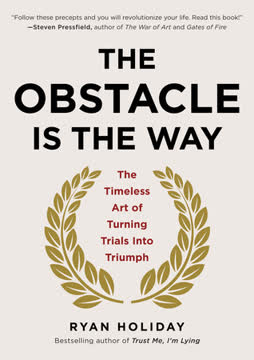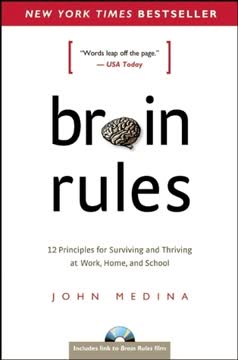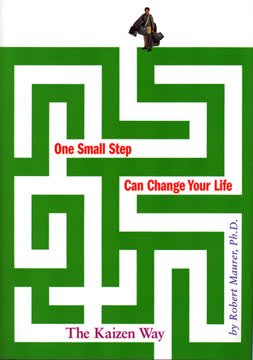Key Takeaways
1. Kaizen: The Power of Small Steps for Big Change
Kaizen is a wonderfully perfect word that literally means "good change."
Origins and essence. Kaizen, a Japanese term meaning "good change," originated in the United States during World War II as a strategy for continuous improvement. It emphasizes making small, incremental changes that accumulate over time to produce significant results. This approach bypasses the brain's natural resistance to change by taking steps so tiny that they don't trigger fear or stress responses.
Application beyond manufacturing. While kaizen is often associated with manufacturing processes, its principles can be applied to various aspects of business and personal life. The book argues that kaizen is particularly effective for management psychology, helping leaders and employees overcome resistance to change, boost morale, cut costs, improve quality, develop new products, increase sales, and even address health-care expenses.
Contrast with innovation. Unlike innovation, which often involves radical, sweeping changes, kaizen focuses on small, doable steps toward improvement. This approach is less likely to trigger resistance and more likely to create lasting change. The book contends that while innovation has its place, an overreliance on radical change can lead to stress, overwhelm, and ultimately, failure.
2. Overcoming Fear: How Kaizen Bypasses Mental Resistance
Change is uncomfortable. It's more than uncomfortable, actually. It can be terrifying.
Understanding brain response. The human brain is wired to respond to change with fear. When faced with significant changes, the amygdala, our brain's alarm center, triggers a stress response that can shut down access to the creative and problem-solving parts of our brain. This physiological reaction explains why many people struggle to make positive changes, even when they know it's in their best interest.
Kaizen's psychological advantage. By taking extremely small steps, kaizen allows individuals to bypass the brain's fear response. These tiny actions are so non-threatening that they don't trigger the amygdala's alarm, allowing people to maintain access to their rational, creative thoughts. This approach enables individuals to build new neural pathways and habits gradually, without experiencing the stress and resistance typically associated with change.
Progressive adaptation. As people become comfortable with small changes, they can incrementally increase the scope of their actions. This gradual progression allows for sustainable change and growth without overwhelming the individual or triggering counterproductive stress responses.
3. Boosting Morale: Micro-Actions for Macro-Impact
Managers are sometimes taught to use the "sandwich technique" of giving a compliment, sliding in a criticism, and then giving another compliment.
The power of appreciation. Small gestures of recognition and appreciation can significantly impact employee morale. The book suggests that managers can improve workplace atmosphere by:
- Greeting employees in the hallway
- Asking about weekend plans
- Saying "thank you" for completed projects
- Using staff members' names
- Putting away smartphones during meetings
Handling difficult people. The book offers strategies for dealing with challenging personalities in the workplace, emphasizing the importance of maintaining neutrality and understanding that difficult behavior often stems from fear. Techniques include:
- Practicing curiosity instead of judgment
- Asking open-ended questions
- Offering genuine compliments
Empowering employees. Encouraging staff to solve problems and make improvements, no matter how small, can significantly boost morale. The book advises managers to be receptive to suggestions and to create an environment where employees feel safe sharing ideas and concerns.
4. Cost-Cutting: Engaging Employees in Continuous Improvement
After less than six months, Roger was eating and drinking much less. His stress levels improved, too. What was Roger's favorite part of the change process? That he never had to undertake any task that lasted longer than five minutes.
Harnessing collective wisdom. The book argues that the most effective way to control costs is to engage all employees in the process of continuous improvement. By encouraging staff to remain alert for wasted resources and inefficiencies, organizations can trim away processes that don't add value or quality.
Small rewards, big results. Rather than offering large financial incentives for cost-saving ideas, the book suggests using small, meaningful rewards. Examples include:
- Personal notes from management
- Bringing an employee their favorite coffee
- Sitting down to discuss an employee's suggestion
Asking small questions. To stimulate cost-saving ideas, managers should ask small, non-threatening questions such as:
- "Can you think of one way we could shave a few dollars off our expenses?"
- "Is there a small step we could take to reduce waste?"
- "What is the very smallest thing we could do to save money?"
5. Quality Control: Addressing Small Mistakes to Prevent Big Problems
Fix the problem, not the blame.
The power of early intervention. The book emphasizes the importance of addressing small mistakes before they escalate into major problems. It uses the example of Toyota's andon cord system, which allows workers to stop the production line to address quality issues immediately, preventing larger issues down the line.
Cultivating transparency. High-reliability organizations (HROs) encourage employees to report mistakes without fear of punishment. This approach allows for early detection and correction of problems, ultimately leading to higher quality and safety standards.
Overcoming mental blindfolds. The book identifies several mental barriers that can prevent organizations from spotting and addressing mistakes:
- Overconfidence in overall success
- Reluctance to question established processes
- Assuming no news is good news
- Believing the organization is too smart to make mistakes
- Diffusing responsibility among multiple parties
6. Fostering Innovation: Cultivating Curiosity and Cross-Collaboration
Creativity is not a cloud, a bolt, or an electric spark. It does not descend upon you as you sit more or less passively in your chair, discontentedly awaiting its arrival as you pound your forehead with your fist. Creativity is not a thing. It's an activity.
Redefining creativity. The book challenges the common perception of creativity as sudden inspiration, instead framing it as an ongoing activity of paying attention to life's seemingly insignificant moments. It argues that innovation often stems from noticing and questioning everyday occurrences that others take for granted.
Cultivating curiosity. To foster creativity, the book suggests:
- Practicing the "curiosity response" in stressful situations
- Asking neutral, open-ended questions
- Looking for opportunities in moments of embarrassment, wastefulness, or boredom
Encouraging cross-pollination of ideas. The book emphasizes the importance of creating physical spaces and opportunities for employees from different departments to interact and share ideas. Examples include:
- Placing copy machines between departments
- Designing long hallways to encourage chance encounters
- Creating small, cramped spaces to maximize interactions
7. Increasing Sales: Dismantling Fear Through Kaizen Techniques
Even for the best salespeople, the act of selling can be intimidating or demoralizing.
Addressing sales anxiety. The book acknowledges that selling can be scary for many people due to the fear of rejection. It proposes using kaizen techniques to help salespeople overcome their anxiety and improve their performance.
Changing inner dialogue. One key strategy is to help salespeople develop more positive self-talk. Examples of constructive inner conversations include:
- "I am offering customers a product (or service) that I believe in."
- "Every no gets me closer to a yes."
- "I am planting seeds for future sales."
Mind sculpture technique. The book introduces "mind sculpture" as a way to mentally rehearse successful sales interactions. This involves vividly imagining every aspect of a sales situation, including sights, sounds, and physical sensations. Regular practice of mind sculpture can help salespeople feel more comfortable and confident in real-life sales situations.
8. Health and Wellness: Applying Kaizen to Employee Well-being
One of the strongest determinants of fullness is purely psychological: it's whether you finish eating everything that's given to you. To feel full with less food, put your meal on a smaller plate.
Small steps for big health improvements. The book argues that even tiny changes in health habits can lead to significant improvements over time. Examples include:
- Drinking four or more cups of water per day to lose two pounds over a year
- Going to bed one minute earlier each night for a week to improve sleep quality
- Taking one-minute exercise breaks throughout the day
Overcoming resistance to change. By using kaizen principles, employees can bypass their fear response and gradually build healthier habits. The book suggests starting with extremely small, non-threatening changes and slowly building on them over time.
Managerial role in health promotion. The book offers strategies for managers to encourage employee health without being pushy or causing defensiveness. These include:
- Modeling healthy behaviors
- Sending brief, encouraging health reminders via email
- Creating opportunities for small, healthy choices in the workplace
9. Navigating Obstacles: Kaizen Strategies for Overcoming Challenges
Action dispels fear.
Identifying common obstacles. The book outlines five major obstacles that can hinder change:
- Overwhelming crises
- Fear and anxiety
- A harsh, critical inner voice
- Isolation
- Looking for answers in the wrong place
Micro-steps for crisis management. In overwhelming situations, the book recommends taking extremely small steps, such as saving one dollar a day, to build new neural pathways and create a sense of control.
Anxiety reduction techniques. Simple breathing exercises and mindfulness practices are suggested to help manage fear and anxiety, allowing for clearer thinking and decision-making.
Reframing self-talk. The book offers strategies for developing a kinder inner voice, emphasizing that harsh self-criticism is counterproductive to change and growth.
Seeking support. Recognizing the importance of community and support, the book provides techniques for overcoming isolation and becoming more comfortable asking for help.
Last updated:
FAQ
What's "The Spirit of Kaizen" about?
- Focus on small steps: "The Spirit of Kaizen" by Robert Maurer emphasizes the power of small, incremental steps to achieve lasting excellence and improvement in various aspects of life and business.
- Kaizen philosophy: The book introduces the concept of kaizen, a Japanese term meaning "good change," which advocates for continuous improvement through small, manageable actions.
- Application in business: It provides practical strategies for leaders and managers to implement kaizen in their organizations to boost morale, cut costs, improve quality, and develop new products.
- Psychological insights: The book also delves into the psychological aspects of change, explaining how small steps can bypass the brain's fear response and facilitate creativity and innovation.
Why should I read "The Spirit of Kaizen"?
- Practical guidance: The book offers actionable advice for implementing kaizen in both personal and professional settings, making it a valuable resource for anyone looking to improve efficiency and effectiveness.
- Overcoming resistance: It provides insights into overcoming resistance to change by using small steps that are less intimidating and more manageable.
- Broad applicability: The principles of kaizen can be applied to various areas, including business management, personal development, and health improvement.
- Proven success: The book includes real-world examples and case studies that demonstrate the effectiveness of kaizen in achieving significant improvements.
What are the key takeaways of "The Spirit of Kaizen"?
- Small steps lead to big change: Incremental improvements can lead to significant and lasting change without triggering fear or resistance.
- Continuous improvement: Kaizen is about making ongoing, small adjustments rather than seeking radical, immediate transformations.
- Employee involvement: Engaging employees in the process of improvement can lead to better morale and more innovative solutions.
- Psychological approach: Understanding the brain's response to change can help in designing strategies that facilitate creativity and problem-solving.
How does Robert Maurer define kaizen in "The Spirit of Kaizen"?
- Literal meaning: Kaizen is a Japanese term that translates to "good change."
- Philosophy of improvement: It emphasizes continuous, incremental improvements rather than drastic changes.
- Historical context: The concept originated in the United States during World War II and was later adopted by Japanese industries to enhance efficiency and quality.
- Application: Kaizen can be applied to various aspects of life and business to achieve lasting excellence.
How can kaizen be applied to boost morale according to "The Spirit of Kaizen"?
- Small gestures of thanks: Simple acts of appreciation can significantly improve employee morale.
- Addressing difficult people: Using small steps to manage difficult personalities can create a more positive work environment.
- Encouraging employee suggestions: Inviting employees to contribute ideas for improvement fosters a sense of involvement and value.
- Creating a supportive culture: A kaizen approach encourages a culture of respect, collaboration, and continuous improvement.
What strategies does "The Spirit of Kaizen" suggest for cutting costs?
- Employee engagement: Encourage employees to identify and suggest small cost-saving measures.
- Small rewards: Offer modest incentives for cost-saving ideas to maintain intrinsic motivation.
- Continuous questioning: Use small questions to prompt employees to think about ways to reduce waste and improve efficiency.
- Integrating cost control: Make cost-saving a part of the corporate mission to ensure it is a continuous effort.
How does "The Spirit of Kaizen" propose improving quality?
- Address small mistakes: Focus on identifying and correcting small errors before they escalate into larger problems.
- Encourage transparency: Create an environment where employees feel safe to report mistakes without fear of punishment.
- Avoid perfectionism: Recognize that mistakes are part of the process and use them as learning opportunities.
- Continuous monitoring: Implement systems to regularly check for quality issues and address them promptly.
What role does curiosity play in developing new products and services in "The Spirit of Kaizen"?
- Attention to small moments: Creativity often arises from paying attention to everyday occurrences and seemingly insignificant details.
- Curiosity response: Train yourself to respond to stress and challenges with curiosity rather than fear.
- Cross-collaboration: Encourage collaboration across different departments to foster innovation and new ideas.
- Embrace mistakes: Use small pilot projects to experiment and learn from mistakes in a controlled environment.
How can kaizen help increase sales according to "The Spirit of Kaizen"?
- Change self-talk: Encourage salespeople to adopt positive internal conversations to boost confidence and resilience.
- Mind sculpture: Use mental rehearsal techniques to practice sales scenarios and reduce anxiety.
- Connect to values: Help sales staff see the impact of their work on customers and the larger mission of the organization.
- Focus on relationships: Emphasize the importance of building and maintaining strong customer relationships.
What are some kaizen strategies for reducing health-care expenses in "The Spirit of Kaizen"?
- Small health changes: Encourage employees to make minor adjustments to their diet and exercise routines for long-term health benefits.
- Mindful eating: Suggest small steps like leaving a bite of food on the plate to promote portion control.
- Incremental exercise: Advocate for short, frequent bouts of physical activity to improve health without overwhelming employees.
- Supportive environment: Create a workplace culture that supports and encourages healthy habits.
What should you do when small steps are too hard according to "The Spirit of Kaizen"?
- Identify obstacles: Recognize common barriers such as fear, anxiety, and isolation that may hinder progress.
- Micro-steps: Break down small steps into even smaller, more manageable actions to reduce resistance.
- Seek support: Encourage collaboration and seek help from others to overcome challenges.
- Reframe self-talk: Replace harsh, critical inner voices with encouraging and supportive self-talk.
What are the best quotes from "The Spirit of Kaizen" and what do they mean?
- "Inches make a champion." - Vince Lombardi: This quote emphasizes the importance of small, consistent efforts in achieving success.
- "Nothing is particularly hard if you divide it into small jobs." - Henry Ford: It highlights the power of breaking down complex tasks into manageable parts.
- "Do your little bit of good where you are; it's those little bits of good put together that overwhelm the world." - Desmond Tutu: This quote underscores the collective impact of small, positive actions.
- "The secret of getting ahead is getting started." - Mark Twain: It encourages taking the first step, no matter how small, to initiate progress.
Review Summary
The Spirit of Kaizen emphasizes continuous improvement through small, incremental steps. Readers appreciate its focus on psychology, neuroscience, and practical applications in both personal and professional settings. Many find it inspiring and actionable, praising its ability to overcome fear and achieve lasting change. The book's emphasis on asking small questions and maintaining a growth mindset resonates with readers. While some criticize it as repackaging familiar ideas, most reviewers find value in its approach to creating lasting excellence through manageable, non-threatening changes.
Similar Books










Download PDF
Download EPUB
.epub digital book format is ideal for reading ebooks on phones, tablets, and e-readers.





